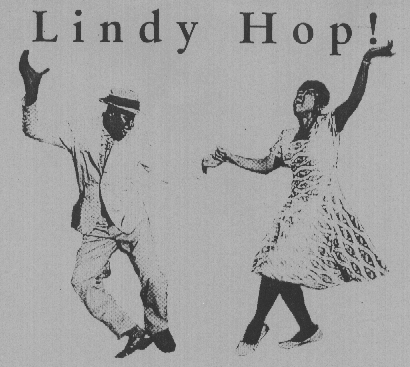What is Lindy Hop?Lindy Hop was so named after Charles Lindbergh's flight to Paris in 1927, when the newspaper headline read: "LINDY HOPS THE ATLANTIC". The dance has no "hop" in it. On the contrary, it is smooth and solid, and while there is a constant rhythmic 8-count "pulse" that you feel in your bones, there is no hopping, bopping, or prancing in the dance.
Lindy Hop is a social dance. Partners are connected smoothly and gently to each other, while relating closely to the music, in feeling, improvisation and phrasing. The core tempo range is 120-180 beats per minute. Films such as Hellzapoppin and Day at the Races, as well as Malcolm X and Swingkids show seemingly reckless airsteps (aerials), often done at very fast musical tempos. Far from being just acrobatic antics, airsteps are in fact smooth, extremely precise, and perfectly in synch with the music. They require a superb degree of expertise and are not danced socially, but only for performance, if only inside a protective ring of spectators, as in the Cats' Corner jams at the Savoy Ballroom. Airsteps are impressive and spectacular, so that's what you see in the movies! Savoy style Lindy Hop, as taught by Frankie Manning and Steven Mitchell, has the lightest, gentlest, and smoothest connection of all the common Swing dances! It is solid, low, relaxed and energetic. Just as Swinging Jazz music feels very different from, say, Rockabilly music, Lindy Hop feels very different from other dances, such as WCS, ECS, Jive, and Rock'N'Roll-Jitterbug, especially in posture, partner connection, and musical connection. Lindy Hop is a Jazz dance. Jazz is dancing music. Swing is Jazz music. |
 Lindy Hop, also known as Jitterbug, is the authentic Afro-Euro-American
Swing dance. It is an unabashedly joyful dance, with a solid, flowing
style that closely reflects its music -- from the late 20's hot Jazz to
the early 40's Big Bands. Just as Jazz combines European and African
musical origins, Lindy Hop draws on African and European
Lindy Hop, also known as Jitterbug, is the authentic Afro-Euro-American
Swing dance. It is an unabashedly joyful dance, with a solid, flowing
style that closely reflects its music -- from the late 20's hot Jazz to
the early 40's Big Bands. Just as Jazz combines European and African
musical origins, Lindy Hop draws on African and European